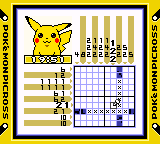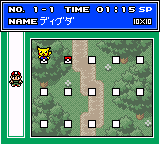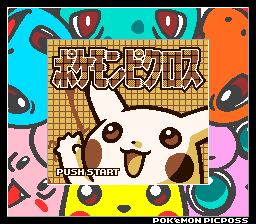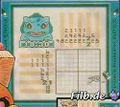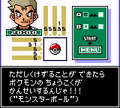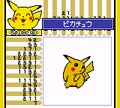Pokémon Picross (GBC)

|
The subject of this article has no official English name. The name currently in use is a fan translation of the Japanese name. |
| Pokémon Picross | |
|---|---|
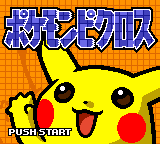 Title screen of the Pokémon Picross prototype | |
Basic info
| |
| Platform: | Game Boy Color (enhanced for the Super Game Boy) |
| Category: | Puzzle prototype |
| Players: | 1 player |
| Connectivity: | None |
| Developer: | Jupiter Corporation |
| Publisher: | Nintendo/The Pokémon Company |
| Part of: | Generation I spin off |
Ratings
| |
| CERO: | N/A |
| ESRB: | N/A |
| ACB: | N/A |
| OFLC: | N/A |
| PEGI: | N/A |
| GRAC: | N/A |
| GSRR: | N/A |
Release dates
| |
| Japan: | N/A |
| North America: | N/A |
| Australia: | N/A |
| Europe: | N/A |
| South Korea: | N/A |
| Hong Kong: | N/A |
| Taiwan: | N/A |
Websites
| |
| Japanese: | N/A |
| English: | N/A |
(Japanese: ポケモンピクロス Pokémon Picross) is a puzzle game for the Game Boy and Game Boy Color. A picross, from picture and crossword, is a genre of puzzle games, also known as a nonogram. It was developed by Jupiter Corporation.
While it was announced in various game magazines in Spring 1999, the game never officially released.
In September 2020, a prototype ROM of the game was posted online. Despite being a prototype, the ROM is fully playable from start to end, and even includes credits.
The game includes 217 puzzles, with each of the 151 Pokémon species from Generation I receiving at least one dedicated puzzle. Togepi from Generation II also makes an appearance.
There are also several references to the original series of the Pokémon anime: some puzzles recreate iconic scenes, and some characters' appearance or mannerisms resemble their anime incarnations.
Gameplay
Pokémon Picross is a nonogram puzzle game where players are presented with a grid of squares, and tasked with using a hammer and chisel to punch out the correct squares to reveal a solution image. Number clues are displayed on the outer edges of the grid's rows and columns, offering information as to how many squares should be punched out per row or column.
Each square can be either punched out, revealing a piece of the image beneath; or marked with an X, indicating that the square should not be punched out. Once all of the correct squares have been punched out (marking all "X" squares is not necessary), the puzzle will be considered complete - the solution image will be zoomed out, gain color, and display its name.
However, unlike traditional nonogram puzzles, the punched-out squares do not themselves form an image - instead, they reveal a layer below the grid that contains the outline of the image.
Puzzles
- Main article: Puzzle (Picross GBC)
The game features 217 puzzles divided into 15 areas.
At the start of a puzzle, the player is offered a hint - if they accept it, they then must time two button presses to determine one row and one column of squares that will each have their solutions revealed. After this (or declining the hint), the puzzle will begin a countdown timer depending on its size:
- 10x10 puzzle: 20 minutes
- 15x15 puzzle: 30 minutes
- 20x20 puzzle: 70 minutes
- 30x30 puzzle: 90 minutes
Additional hints can be requested from the pause menu, however each will deduct 5 minutes from the puzzle's timer.
If a square is incorrectly punched out, it will be automatically corrected to an X, but time will be deducted from the puzzle's timer. The time penalty will increase with the amount of mistakes in a single puzzle attempt:
- First mistake: -1 minute
- Second mistake: -2 minutes
- Third mistake: -4 minutes
- Fourth mistake and onwards: -8 minutes
However, squares incorrectly marked with an X will not be corrected, and will not incur a time penalty.
If a puzzle's timer reaches zero, whether naturally or through penalties, the attempt is considered a failure and the player will need to try the puzzle again from scratch.
A tutorial on puzzle mechanics is available in the "Tutorial" option in the game's main menu, and is narrated by Professor Oak.
Four-quadrant puzzles
10x10 and 15x15 puzzles are played on one screen, while 20x20 puzzles are played as four separate 10x10 quadrants, each with their own separate number clues. 30x30 puzzles play similarly, as four separate 15x15 quadrants.
The top-left quadrant is always the first quadrant the player must solve.
When a quadrant is solved, the overall timer will pause, and the quadrant will display its own solve time instead. The player is then prompted to choose any of the four quadrants to attempt next. If an already-solved quadrant is selected, then it can be re-attempted for a better solve time without resetting the other quadrants. However, this retry feature is disabled for puzzles appearing in area 8 onwards, as well as the safari area
Once all four quadrants have been solved, the overall puzzle will be considered solved.
Safari Puzzles
The "Safari Picross" mode makes several changes to the rules:
- The maximum time limit for each puzzle is reduced by 10 minutes.
- Puzzles will not offer a hint at the start, nor can hints be requested. Incorrect punch-outs will still incur time penalties, as normal.
- The hint option in the pause menu is replaced by "?start". When this is enabled, incorrectly-punched-out squares will neither be corrected nor incur a time penalty. When the mode is disabled, the player may choose to keep or discard the changes they made while in the mode.
- If the changes are kept, then they are saved to the grid's current state. Any incorrectly-punched-out squares will be corrected and incur time penalties, as usual.
- If the changes are discarded, then the grid will return to its state from before the mode was enabled.
- If the changes would result in the puzzle being correctly solved, then the mode is automatically disabled, and the puzzle will immediately be considered solved.
- On four-quadrant puzzles, the player is not notified when a quadrant is correctly solved. Instead, they will only be notified once all four quadrants are correctly solved. As a result, the current quadrant must be manually switched by the player, and the switch can be performed at any time.
A tutorial explaining some of these changes is available under "Safari Tutorial", and is narrated by Bill.
Map
Upon completing a puzzle, it will be marked with a Poké Ball icon on the map screen. If the puzzle was completed within the puzzle's specific "par time", then it will be marked with a Great Ball instead. During a puzzle attempt, if the remaining time is still within par range, the puzzle's timer will use white text; if the par period has passed, the timer will play a sound cue and then switch to black text.
- When playing on a Game Boy or a Super Game Boy, Poké Balls will instead render as a ball with two light halves (resembling a Premier Ball, which did not debut until Generation III), while Great Balls will render as a ball with a dark upper half and light lower half.
Selecting an unsolved puzzle on the map will instantly start it. Selecting an already-completed puzzle will offer the choice to replay the puzzle or view the puzzle's "data" - its entry in the Pokédex or gallery.
The game is divided into 15 areas, with most areas containing 15 puzzles each. The first 14 puzzles in each area may be attempted in any order, but the 15th puzzle can only be played once at least 8 different puzzles in that area have been marked with a Great Ball. To unlock the next area, at least 8 puzzles in the current area must be solved with at least a Poké Ball.
- Area 0 is the sole area in the "Easy Picross" mode, and features a tutorial from Misty regarding generic map mechanics.
- Areas 1-10 are located in the "Pokémon Picross" mode, and must be completed in sequence.
- Area 10 includes an additional 16th puzzle, which becomes available after all 150 previous Pokédex-eligible puzzles have been completed.
- Completing 8 puzzles in area 10 unlocks the "Safari Picross" mode, which includes 4 areas.
- Safari areas 1-3 only require 4 puzzles to be solved with a Great Ball to unlock the 15th puzzle. However, unlocking the next area still requires solving 8 puzzles with at least a Poké Ball.
- Safari area 4 includes only 6 puzzles. The sixth puzzle appears after completing two puzzles in that area with a Great Ball.
Pokédex and galleries
Most puzzles in the game each represent a Pokémon. Completing a Pokémon's puzzle will add them to the Pokédex, where their completed image can be viewed, their cry can be played, and their puzzle can be jumped to in order to retry it.
- Puzzles in area 0 instead feature items or objects, and are thus not added to the Pokédex when solved. There is also no central gallery to view all of area 0's puzzles at once - their entries can only be viewed one at a time from the map.
- Puzzles in Safari areas are added to the Safari gallery instead.
- Pikachu's Pokédex entry uses its cry from the anime, voiced by Ikue Otani.
Puzzles that have been completed with a Great Ball will display a grayscale Poké Ball icon next to their name in their respective galleries.
The Pokédex will initially list 150 slots for entries. The 151st entry will appear only after solving Mew's puzzle at the end of area 10.
Partner Pokémon
The player's current partner Pokémon will follow them on the map screen, as well as appear in the top-left of the screen during 10x10 and 15x15 puzzles, reacting to player actions such as making a mistake, running out of time, or successfully solving a puzzle. Each partner Pokémon also changes the background music and border color when playing puzzles.
The player starts with Pikachu as their partner Pokémon, and can obtain several others as they progress through the game.
| Partner Pokémon | Border color | Location |
|---|---|---|
| Pikachu | Yellow | Default |
| Bulbasaur | Green | Start of area 2 |
| Charmander | Red | Start of area 4 |
| Squirtle | Blue | Start of area 6 |
| Clefairy | Pink | Start of area 8 |
| Jigglypuff | Purple | Start of area 10 |
However, partner Pokémon do not appear in 20x20 or 30x30 puzzles - a zoom-out of the puzzle appears in their place - and the puzzle border will automatically change color depending on the current 10x10 quadrant selected: blue (top-left), yellow (top-right), red (bottom-left), or green (bottom-right). Despite this, the partner's background music will still be played.
Saving
Two save files are available. The game will automatically save to the currently-played file at the following times:
- After successfully completing a puzzle.
- Upon going to the main menu screen.
Alternatively, a quick-save can be manually created from the pause menu while attempting a puzzle. Continuing from this quick-save will preserve the state of the puzzle grid - however, the quick-save will be deleted upon being loaded.
The screen shown after creating a quick-save shows Nurse Joy - this is her only appearance in the entire game.
Memories
The game includes three possible animations played alongside the credits, called "memories". Each memory will automatically play once its conditions are met. Unlocked memories can be viewed again at any time from the main menu.
- Normal: Solve 8 puzzles in area 10 of "Pokémon Picross" mode.
- Master: Solve all 151 Pokédex-eligible puzzles in "Pokémon Picross" mode.
- Safari: Solve all puzzles in "Safari Picross" mode.
If the Master memory is unlocked before the Safari memory, then at the end of the animation Misty will instruct the player solve all Safari puzzles. If the Safari memory is unlocked first instead, Misty will tell the player to complete the Pokédex.
If both the Master and Safari memories have been unlocked, then Misty's dialogue in both memories is replaced with an acknowledgement that the player is a Pokémon Picross Master. If the memories are re-viewed from the main menu, this text will be retroactively applied to both.
Compatibility
The game was intended to work with the Game Boy Printer. Any completed puzzle can be printed from its corresponding gallery, or from the Pokédex.
The game also has a Super Game Boy border. However, it does not have a custom color palette, so the game will display in the Super Game Boy's default monochrome brown.
References to the anime
The game has numerous direct references to the original series of the Pokémon anime.
Puzzles:
- Puzzle 0-10 features Jigglypuff's microphone marker.
- Puzzle 0-15 features Ash's hat from the original series.
- Safari Puzzle 1-13 features a Ditto transformed into a Pikachu, though retaining Ditto's face. This is a reference to Duplica's Ditto from Ditto's Mysterious Mansion
- Safari Puzzle 1-14 features the Squirtle Squad using Water Gun to douse flames, referencing Here Comes the Squirtle Squad.
- Safari Puzzle 2-2 features a Squirtle warming up with a Charmander's tail flame, referencing a similar scene in Snow Way Out!.
- Safari Puzzle 2-3 features a Pinsir attempting to crush a Metapod between its pincers, referencing Challenge of the Samurai.
- Safari Puzzle 2-5 features a Shellder clamping onto the tail of a Psyduck, referencing The Evolution Solution.
- Safari Puzzle 2-13 features a Wigglytuff using Double Slap on a Meowth, referencing Lights, Camera, Quack-tion.
- Safari Puzzle 3-1 features a Hitmonlee and Hitmonchan battling in a boxing ring, referencing The Punchy Pokémon.
- Safari Puzzle 3-4 features a Pikachu using Thunder Shock on a Geodude, referencing Showdown in Pewter City.
- Safari Puzzle 3-10 features a Togepi among Exeggcute, referencing the Pikachu short Pikachu's Rescue Adventure.
- Safari Puzzle 3-12 features a Rapidash and Dodrio competing in a race, referencing The Flame Pokémon-athon!.
- Safari Puzzle 3-13 features a Psyduck seemingly having a conversation with a Slowbro, again referencing The Evolution Solution.
- Safari Puzzle 4-3 is titled "Team Rocket" (Japanese: ロケットだん Rocket-dan) and features a Meowth, Koffing, and Ekans, referencing the Team Rocket trio.
- Safari Puzzle 4-5 is titled "Pokémon of the Hidden Village" (Japanese: かくれざとのポケモン) and features a Bulbasaur and an Oddish, referencing Bulbasaur and the Hidden Village.
Characters and partner Pokémon:
- Bill has green hair, a trait that otherwise only appears in the anime episode Mystery at the Lighthouse.
- Upon clearing a puzzle with Jigglypuff as the partner, it sings while holding its microphone marker.
- Upon failing a puzzle with Squirtle as the partner, it puts on black angular sunglasses and cries behind them. These sunglasses are identical to those worn by Ash's Squirtle.
In the Master memory:
- Misty accompanies the player to various locations, alongside a Psyduck. This Psyduck has an overworld sprite that only appears in this memory and the Safari memory, in both cases alongside Misty.
- Bill looks out to sea from atop his lighthouse, again referencing Mystery at the Lighthouse. Interestingly, the game calls this location the "Sea Cottage", which is the core series counterpart to Bill's Lighthouse.
- Pikachu and the player watch the full moon alongside a Clefairy on Mt Moon, likely referencing Clefairy and the Moon Stone.
- Pikachu, Charmander, and the player enter Pokémon Tower, but are frightened and quickly run back out of the building. This is likely a reference to The Tower of Terror.
- Pikachu and the player exit a power plant, and are followed by multiple Pikachu. This may be a reference to Pokémon Emergency!.
Staff
- Main article: Staff of Pokémon Picross (GBC)
History
Though Pokémon Picross was never officially released, the SNES game Picross NP Vol. 1 released in 1999 included 12 Pokémon puzzles. Prior to that, the Pokémon Gold and Silver Spaceworld '97 demo also contained a Picross minigame.
The international versions of Pokémon HeartGold and SoulSilver featured a game similar to picross at the Goldenrod Game Corner, Voltorb Flip.
Pokémon Picross, a freemium game for the Nintendo 3DS also developed by Jupiter Corporation, was released on the Nintendo eShop in December 2015.
Gallery
Magazine Pages
External links
Some magazines featuring Pokémon Picross:
- CoroCoro - May 1999 issue (published on 15 April, 1999)
- CoroCoro - June 1999 issue (published on 15 May, 1999)
Trivia
- If the game is left idle on the title screen, Professor Oak's tutorial will automatically play. If the game continues to be left idle after this, a demo sequence will play: the player character, with Pikachu as their partner, go to puzzle 4-8 and solve it. The solution is Pikachu, however this puzzle is completely different from the playable Pikachu puzzle. Additionally, the solution for puzzle 4-8 in the playable game is Vulpix instead.
- Mewtwo appears on the overworld map of area 10, but its puzzle appears in area 7 instead.
- Safari puzzles 1-11 and 3-15 reference the Japanese folktale of the Monkey-Crab Battle, with Mankey representing the monkey and Krabby representing the crab.
- Safari puzzle 1-13 shares its name with the 8th book in the Pokémon Tales series.
- Jigglypuff is the only partner Pokémon who does not have a blinking animation during puzzles. Instead, its eyes will occasionally shine.
- Magazine previews of the game included a Horsea puzzle that does not appear in the prototype.
- The Super Game Boy border incorrectly spells "Picross" as "Picposs".
| Beta versions of Pokémon games | |||||||||
|---|---|---|---|---|---|---|---|---|---|
| |||||||||

|
This article is part of Project Sidegames, a Bulbapedia project that aims to write comprehensive articles on the Pokémon Sidegames. |
